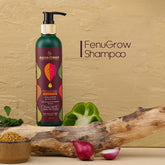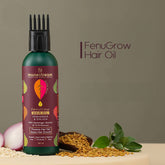Which is the best ayurvedic shampoo for your hair?

Are you saying goodbye to your chemical-laden shampoos? Given the harm they've done to your hair, if you're wanting to refresh your hair care routine by switching to ayurvedic shampoos, your hair will undoubtedly thank you for your decision! Natural cleansers abound in our plentiful nature and have long been a part of Indian customs. Ayurveda has a well-documented pharmacopeia that suggests professional methods to use them. Synthetic cleansers, while more convenient to use, take their toll on your hair and scalp in the long term. As a result, we are here to assist you in selecting the best ayurvedic shampoo for your hair. Prepare to heal your scalp and hair problems naturally with homemade Ayurvedic shampoos.
What is an ayurvedic shampoo? Is ayurvedic shampoo good for your hair?
An 'ayurvedic shampoo' is any hair cleansing treatment manufactured from the extracts of Ayurvedic plants and flowers.
Surfactants in chemical shampoos, such as sulfates and their derivatives, deplete your scalp's natural oils and harm its tissues and cuticles. Ayurvedic shampoos, on the other hand, are gentle and natural. They aid in the preservation of scalp oils while also supporting healthy and glossy hair growth.
How to Choose the Best Ayurvedic Shampoo?
According to ancient Ayurvedic literature, our body, mind, and soul is made up of the three basic life energies: Vata, Pitta, and Kapha doshas. And the balance of these important energies is critical to your overall well-being. When any of these doshas become imbalanced, it causes disruption of our biological systems, resulting in a variety of ailments.
Your hair and scalp issues, according to this Ayurvedic philosophy of human health, are the result of an imbalance in your dosha levels. Ayurveda, our Indian traditional science, provides remarkable herbal formulations to bring high doshas back into balance, while the therapeutic ingredients in the herbs fix your hair issues.
In this way, the ancient knowledge of our Indian sages provided the groundwork for treating the fundamental cause of hair issues rather than merely treating the symptoms, as modern-day health science does. To select the best ayurvedic shampoo, you must first understand your doshas, which are based on your hair and scalp problems.
Understand your Hair
Ayurvedic Shampoos depending on your hair needs

Effect on the Doshas:
Helps balance the doshas Kapha and Pitta. Shikakai, which contains natural saponins, is a good cleanser of debris and excess sebum while preserving the natural oils of your scalp and hair. Its anti-fungal, anti-oxidant, and cooling characteristics make it ideal for treating dandruff, lice infection, scalp inflammation, premature greying, and other disorders. Shikakai naturally strengthens your roots and detangles your hair, encouraging long and smooth hair growth.
How to Use:
- 5-6 soap pods and 2-3 soap nuts should be soaked in 2-3 cups of water overnight.
- Boil these things in the water that they were soaked in the next morning until tender.
- If your hair is more oily, boil the solution until it becomes thick.
- After the solution has cooled, filter off the herbs and keep them in a container.
- Apply the shampoo to your scalp and hair gently. Massage your scalp and hair for a few minutes before rinsing with warm water.
- You can use this ayurvedic shampoo twice a week for improved results if you have Kapha or Pitta hair issues.
- If you have Vata dosha troubles, add 2 tsp of fenugreek seeds to the recipe and utilize it.
Effect on the Doshas:
Balances all three doshas, particularly Pitta. Amla is well recognized for its ability to reduce hair fall since it stimulates hair growth by creating collagen. Collagen fortifies hair roots by replacing dead cells with new ones. Amla also naturally moisturizes cuticles and heals broken ends. It is most effective for treating dry dandruff.
How to Use:
- Mix 2 teaspoons of amla powder and 2 teaspoons of Shikakai powder.
- Pour in enough water to make a smooth and uniform paste. Your amla shampoo is complete.
- Spread the paste from your scalp to your hair tips.
- Allow it to sit for around 40 minutes before washing it off with water and massaging your scalp gently.
- This hair cleanser is suitable for all hair types and should be used once a week.
Effect on the Doshas:
Balances the doshas Kapha and Vata. Brahmi is a potent Ayurvedic herb that is widely recognized for treating stress-related hair loss. It promotes hair development by feeding the roots thoroughly. Brahmi keeps your scalp cool and treats ailments such as itching, dry scalp, and dandruff. It also adds luster to your hair and increases volume.
How to Use:
- In equal portions, combine Brahmi powder, amla powder, and shikakai powder.
- To form a paste with a liquid consistency, add water.
- Apply the paste to damp hair and allow it for a few minutes to dry.
- Wash it off with water, rubbing your scalp gently.
- While Brahmi alone is beneficial for Kapha and Vata hair types, the addition of shikakai and amla makes it suitable for all hair types.
- Cleanse your hair with Brahmi shampoo once a week for optimum results.
Effect on the Doshas:
Vata and Kapha are balanced. Fenugreek, also known as methi, includes natural saponins and mucilaginous components that help you regulate scalp dryness by regulating its pH levels. It is quite beneficial for promoting hair growth, natural hair smoothing, and retaining your natural hair color. It gives excellent and rapid relief from dry dandruff and hair thinning while preserving proper moisture levels on your scalp and hair. With methi, your hair regains its natural radiance.
How to Use:
- Soak 8-10 grams of fenugreek seeds overnight in water.
- The next morning, grind the seeds into a fine paste.
- Apply the paste to your scalp and hair thoroughly.
- Allow it to sit for around 30 minutes before washing with warm water.
- If you have dry, rough hair with split ends, you should use this fenugreek shampoo three times a week.
Effect on the Doshas:
It reduces Pitta and Kapha while increasing Vata. Neem includes stearic acid, oleic acid, and linoleic acid, which nurture and condition your scalp and hair. It is well recognized as a hair growth booster, but its anti-fungal and anti-inflammatory qualities also assist to prevent scalp irritation, itchy dandruff, and scalp inflammation. It also makes your hair smooth and silky. Although it somewhat increases Vata, its deep conditioning capabilities aid in the treatment of split ends and frizzy hair.
How to Use:
- Mix a few neem leaves with a splash of water until fine and smooth paste forms.
- Apply the paste to your scalp and hair, working your way from the roots to the tips.
- Exfoliate your scalp and hair for a few minutes and then leave it for 30 minutes.
- Using cold water, thoroughly rinse your scalp and hair.
- People with any hair type can use neem paste as a hair cleaner once a week.
Effect on the Doshas:
All three doshas are balanced. Kumari stimulates hair development and heals damaged hair with deep nutrition and conditioning. In addition to relaxing your scalp irritation, it delivers deep cleansing to greasy hair. Kumari's antibacterial qualities also keep scalp diseases at bay.
How to Use:
- Take fresh aloe vera gel off the plant and place it in a basin.
- Mix 2 teaspoons coconut milk and 1 teaspoon apple cider vinegar.
- To get a uniform solution, thoroughly combine the ingredients.
- Pour this solution immediately over your scalp and hair to use as a hair rinse.
- Allow the solution to distribute evenly and for around 1-2 minutes before washing it off with water.
- It is ideal for usage if you have dry and brittle hair since coconut milk nourishes and hydrates your hair strands while apple cider vinegar gives your hair a smooth and soft texture.
- Aloe vera gel may be used as an ayurvedic shampoo on its own for any type of hair.
Advantages of using an Ayurvedic Shampoo
- Ayurvedic shampoos offer the same cleaning efficiency as chemical shampoos, yet natural herbs are devoid of the adverse effects produced by sulfates and parabens.
- The majority of ayurvedic shampoos have natural conditioning and smoothing effects. When utilizing ayurvedic shampoos, you may want to avoid applying chemical conditioners after shampooing.
- Ayurvedic shampoos naturally balance the pH levels of your scalp and hair while retaining proper quantities of scalp oils.
- Aside from washing, ayurvedic shampoos promote healthy hair growth by giving natural sustenance in the form of key vitamins and minerals found in herbs.
- Herbal washes do not remove chemical hair coloring as do chemical shampoos. Rather, they aid in the improvement of your hair's natural color and sheen.
- Ayurvedic shampoos are eco-friendly since the chemicals are biodegradable.





